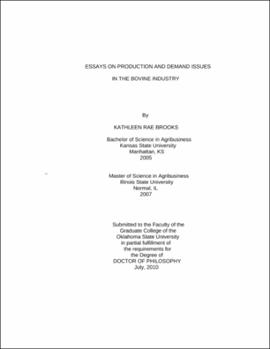| dc.contributor.advisor | Lusk, Jayson | |
| dc.contributor.author | Brooks, Kathleen Rae | |
| dc.date.accessioned | 2013-11-26T08:21:59Z | |
| dc.date.available | 2013-11-26T08:21:59Z | |
| dc.date.issued | 2010-07 | |
| dc.identifier.uri | https://hdl.handle.net/11244/6507 | |
| dc.description.abstract | Scope, Method of Study, and Findings: This three-essay dissertation seeks to address both production and demand issues in the bovine industry. The first essay assesses the economic effects of bovine respiratory disease (BRD) in backgrounding and finishing phases with risk assessment of calves based on serum haptoglobin (Hp). During a 63-day backgrounding phase, heifers (n=337) were grouped by Hp level and monitored daily for signs of BRD. After backgrounding, heifers (n=193) were allocated to finishing pens based on number of BRD treatments received. Hp concentration had no significant effect on net returns and was not significantly different across number of BRD treatments. However, net returns decreased in the backgrounding phase and the combined backgrounding-finishing phases as number of BRD treatments increased. | |
| dc.description.abstract | The final two papers use data from a nationwide survey to elicit consumer's preferences for meat and milk from cloned products. The U.S. Food and Drug Administration recent announcement that products from cloned animals is safe to consumer, prompted interest among farmers, food retailers, and regulators in the market impacts of the introduction of milk from clones. Because milk from cloned animals is not currently labeled in the market, we utilized a stated preference experiment to determine consumer preferences for the attribute. The second essay also sought to determine whether the survey-based choices were consistent with people's revealed preferences given by scanner data. Our analysis indicates that a pooled model combining stated and revealed preference data exhibits overall better out-of-sample prediction performance than either data set used alone. Results from the pooled model indicate consumers are willing to pay large premiums to avoid milk from cloned cows - an amount that is over three times that for organic or rBST-free milk. The results are used to calculate the value of a mandatory labeling program | |
| dc.description.abstract | The purpose of the third essay is to test the often implicit assumption that data on people's private shopping choices are often used to draw implications about their desires for food policies. We find that although people's private choices indicate a strong desire to avoid meat and milk from cloned cattle, implying a significant willingness-to-pay to ban food from cloned animals, that when directly asked, most people oppose a ban and would demand compensation through lower food prices were a ban enacted. The results suggest caution in inferring public preferences from private choices. | |
| dc.format | application/pdf | |
| dc.language | en_US | |
| dc.rights | Copyright is held by the author who has granted the Oklahoma State University Library the non-exclusive right to share this material in its institutional repository. Contact Digital Library Services at lib-dls@okstate.edu or 405-744-9161 for the permission policy on the use, reproduction or distribution of this material. | |
| dc.title | Essays on production and demand issues in the bovine industry | |
| dc.contributor.committeeMember | Ward, Clement E. | |
| dc.contributor.committeeMember | Raper, Kellie Curry | |
| dc.contributor.committeeMember | Krehbiel, Clinton R. | |
| osu.filename | Brooks_okstate_0664D_10972 | |
| osu.accesstype | Open Access | |
| dc.type.genre | Dissertation | |
| dc.type.material | Text | |
| dc.subject.keywords | animal cloning | |
| dc.subject.keywords | bovine respiratory disease | |
| dc.subject.keywords | choice experiment | |
| dc.subject.keywords | haptoglobin | |
| dc.subject.keywords | scanner data | |
| dc.subject.keywords | stated preference data | |
| thesis.degree.discipline | Agricultural Economics | |
| thesis.degree.grantor | Oklahoma State University | |
